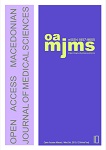Activity Anticancer n-hexane Fraction of Cyperus Rotundus l. Rhizome to Breast Cancer MCF-7 Cell Line
DOI:
https://doi.org/10.3889/oamjms.2019.530Keywords:
Cyperus rotundus L, MCF-7, Cytotoxic, ApoptosisAbstract
BACKGROUND: Cancer is one of the causes of morbidity and mortality worldwide. Breast cancer is one of the most common types of cancer in Indonesia. Failures that often occur in the treatment of cancer primarily through chemotherapy, synthetic drugs that have side effects include anemia, alopecia, cardiotoxic and hepatotoxic due to low anti-cancer selectivity and unclear carcinogenesis process. Cyperus rotundus L. rhizome is one of the medicinal plants that potential enough to be developed as an anticancer agent.
AIM: The aim of this study was to anticancer activity n-hexane fraction Cyperus rotundus L. rhizomes to breast cancer MCF-7 cell line in vitro.
METHODS: Cyperus rutundus L. rhizomes powder was extracted ethanol by percolation then fractionated with n-hexane. Phytochemical screening was then carried out. The cytotoxic activity of the n-hexane fraction was determined by observing this extract on MCF-7 cells using the (3- (4,5-dimethylimidazole-2-il) -2,5-diphenyl tetrazolium bromide) (MTT). Selectivity index (IS) of normal cells (Vero cells). Cell cycle and apoptosis induction were analyzed by flow cytometry.
RESULTS: The result showed that the fraction n-hexane Cyperus rutundus L. rhizome has anticancer activity against breast cancer MCF-7 cells with accumulation cell cycle in the G0-G1 phase and through induction of apoptosis.
CONCLUSION: The n-hexane fraction Cyperus rotundus L. rhizome has potent anticancer activity.
Downloads
Metrics
Plum Analytics Artifact Widget Block
References
Zampieri L, Bianchi P, Ruff P, Arbuthnot P. Differential modulation by estradiol of P-glycoprotein drug resistance protein expression in cultured MCF7 and T47D breast cancer cells. Anticancer Res. 2002; 22(4):2253-9.
Lawal O, Oyedeji A. Chemical Composition of the Essential Oils of Cyperus rotundus L. from South Africa. Molecules. 2009; 14(8):2909-17. https://doi.org/10.3390/molecules14082909 PMid:19701133 PMCid:PMC6254851
Massarani et al. Composition & biological activity of Cyperus rotundus L. tuber volatiles from Saudi Arabia. Natural Volatiles & Essential Oil. 2016; 3(2):26-34.
Kilani S, Ben Sghaier M, Limem I, Bouhlel I, Boubaker J, Bhouri W, et al. In vitro evaluation of antibacterial, antioxidant, cytotoxic and apoptotic activities of the tubers infusion and extracts of Cyperus rotundus. Bioresource Technology. 2008; 99(18):9004-8. https://doi.org/10.1016/j.biortech.2008.04.066 PMid:18538563
Sayed HM, Mohamed MH, Farag SF, Mohamed GA, proksch P. A new steroid glycoside and furochromones fromCyperus rotundusL. Natural Product Research. 2007; 21(4):343-50. https://doi.org/10.1080/14786410701193056 PMid:17479423
Susianti. Cytotoxic Effect of Purple Nut Sedge Tuber (Cyperus rotundus L.) Methanol and Chloroform Extract on HeLa and SiHa Cells. PAAI. Yogyakarta. Indonesia, 2009.
Nidugala H, Avadhani R, Prabhu A, Basavaiah R. In vitro cytotoxic activity of rhizome extracts of Cyperus rotundus (L.) against colon carcinoma and Ehrlich ascites carcinoma. Journal of Applied Pharmaceutical Science. 2016; 172-5. https://doi.org/10.7324/JAPS.2016.601127
A NVD, I SS. Anticancer activity and cell cycle arrest evoked by ethanolic extract of cyperus rotundus in kb oral cancer cell lines. International Journal of Pharma and Bio Sciences. 2017; 8(2). https://doi.org/10.22376/ijpbs.2017.8.2.b757-765
Directorate General of Drug and Food Control. Indonesian Pharmacopeia. Edition IV. Jakarta: Ministry of Health of Republik Indonesia, 1995:969-971; 1033.
M, Harahap U, Nasution MP, Ilyas S. The activity of <i>Rhaphidophora pinnta</i> Lf. Schott leaf on MCF-7 cell line. Advances in Biological Chemistry. 2013; 03(04):397-402. https://doi.org/10.4236/abc.2013.34042
CCRC (Cancer Chemoprevention Research Centre). Protocol Kultur Sel. Yogyakarta: Cancer Chemoprevention Research Centre, 2013:1-7.
Ueda J, Tezuka Y, Banskota AH, Tran QL, Tran QK, Harimaya Y, et al. Antiproliferative Activity of Vietnamese Medicinal Plants. Biological & Pharmaceutical Bulletin. 2002; 25(6):753-60. https://doi.org/10.1248/bpb.25.753 PMid:12081142
Weerapreeyakul N, Nonpunya A, Barusrux S, Thitimetharoch T, Sripanidkulchai B. Evaluation of the anticancer potential of six herbs against a hepatoma cell line. Chinese Medicine. 2012; 7(1):15. https://doi.org/10.1186/1749-8546-7-15 PMid:22682026 PMCid:PMC3502167
Kumar, V., Abas, A.K., dan Foustro, N. Pathology Basic of Dissease. New York: Elsevier Incoorporation, 2005:270-336.
Ruddon, R.W. Cancer Biology. New York: Oxford University Press, 2007:117-196.
Petronelli A, Pannitteri G, Testa U. Triterpenoids as new promising anticancer drugs. Anti-Cancer Drugs. 2009; 20(10):880-92. https://doi.org/10.1097/CAD.0b013e328330fd90 PMid:19745720
Cucurbitacins as Inducers of Cell Death and a Rich Source of Potential Anticancer Compounds. Current Pharmaceutical Design. 18(12):1663-76. https://doi.org/10.2174/138161212799958549 PMid:22443631
Downloads
Published
How to Cite
Issue
Section
License
Copyright (c) 2019 Delisma Simorangkir, Masfria Masfria, Urip Harahap, Denny Satria (Author)

This work is licensed under a Creative Commons Attribution-NonCommercial 4.0 International License.
http://creativecommons.org/licenses/by-nc/4.0








